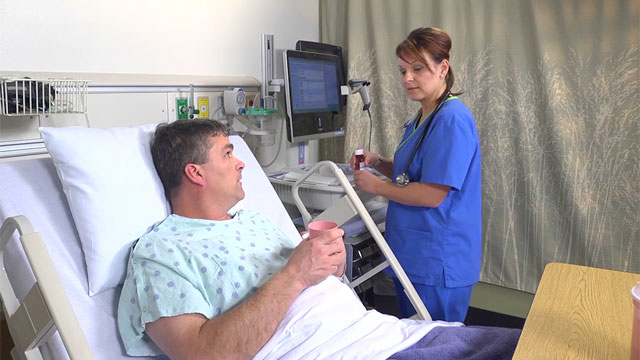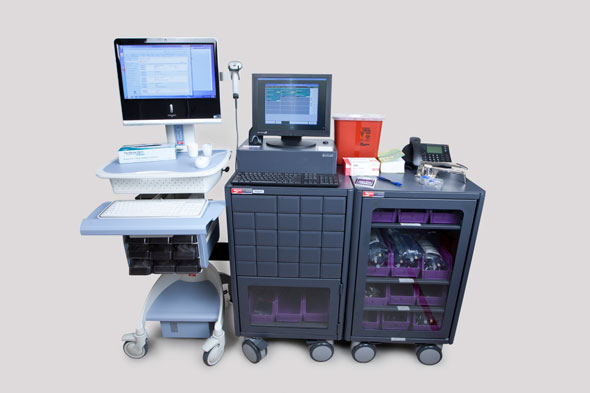Safe Medication Administration
Select a Skill:
- » Ensuring The Six Rights of Medication Administration
- » Administering Oral Medications
- » Documenting Medication Administration
- » Handling Medication Variations
- » Preventing Medication Errors
- » Using Automated Medication Dispensing Systems
Take the Review Test:

Safety
- Assess the patient’s ability to swallow, and assess for the presence of a gag reflex. Follow aspiration precautions for patients who have difficulty swallowing.
- Give oral medications with a full glass of water (unless restricted or contraindicated) to aid passage of the drug.
- Do not divide a tablet in half unless it has been scored by the manufacturer.
- Do not crush enteric-coated, long-acting, sustained-release, or sublingual medications. Refer to the “Do Not Crush List” issued by the Institute for Safe Medication Practices (ISMP).
- When a liquid medication must be given by syringe, use a syringe specifically designed for oral use.
- When giving medications to swallow at the same time as sublingual or buccal medications, give the sublingual or buccal medication last. Do not give additional liquids until the buccal or sublingual medication has dissolved.
- Keep tablets and capsules in their wrappers, and open them at the patient’s bedside.
- Observe the patient taking all medications.
Equipment
(Roll cursor over items to see labels)

Medication (from dispensing system)
Disposable medication cups
Medication administration record (MAR)
Device for crushing or splitting tablets (if needed)
Clean gloves (if handling an oral medication)
Delegation
The skill of administering oral medications may not be delegated to nursing assistive personnel (NAP). Before delegating related skills, be sure to inform NAP of the following:
- Review the expected therapeutic effects and potential side effects to report to you.
- Instruct NAP to inform you if the patient’s symptoms (such as pain or itching) continue or worsen after the PRN medication is administered.
Preparation
- Check the accuracy and completeness of each medication administration record (MAR) against the health care provider’s medication order. Confirm the patient’s name, the drug and dosage, the route of administration, and the time of administration. Clarify incomplete or unclear orders with the health care provider.
- Note if the patient has allergies.
- Review pertinent information related to the medication, including its action, purpose, normal dose and route, side effects, time of onset and peak action, and nursing implications.
- Assess for any contraindications to receiving oral medications, including NPO status, inability to swallow, nausea/vomiting, bowel inflammation, reduced peristalsis, recent GI surgery, gastric suction, and decreased level of consciousness (LOC). Notify the health care provider if any contraindications are present.
- Protect the patient from aspiration by assessing his or her swallowing ability.
- Review appropriate preassessment data, including physical assessment, vital signs, and lab values specific to the medications being given that may require holding medication or obtaining an order for alternative dosing.
- Assess the patient’s preference for fluids, and determine if medications can be given with these fluids. Maintain fluid restrictions if prescribed.
Follow-up
- Return within an appropriate time to evaluate the patient’s response to the medication, including therapeutic effects, side effects, allergic reactions, or adverse reactions. Sublingual and buccal medications begin to act in 15 minutes; most oral medications begin to act within 30 to 60 minutes.
- Review with the patient or caregiver the name of the drug and its purpose, action, prescribed dosage, dosage schedule, and potential side effects.
- Report the patient’s response, side effects, and/or withheld doses to the health care provider.
Documentation
- Record the drug, dose, route, and time administered on the MAR immediately after administration, not before. Include your initials or signature.
- Record patient teaching and validation of understanding in the nurses’ notes.
- If a drug is withheld, record the reason in the nurses’ notes, and follow agency policy for noting withheld doses.
Review Questions
1. How might the nurse safely administer an extended-release capsule to a patient with dysphagia?
 Encourage the patient to drink plenty of water when swallowing the capsule.
Encourage the patient to drink plenty of water when swallowing the capsule. Open the capsule, and place the contents into 90 mL (3 fl. oz.) of juice.
Open the capsule, and place the contents into 90 mL (3 fl. oz.) of juice. Place the capsule in a spoonful of the patient’s applesauce.
Place the capsule in a spoonful of the patient’s applesauce. Save the capsule to be administered last.
Save the capsule to be administered last.
2. The nurse is preparing to administer several oral medications when the patient says he would like to take his pills with orange juice. What is the nurse’s best response?
 Determine whether the patient’s prescribed diet includes orange juice.
Determine whether the patient’s prescribed diet includes orange juice. Establish whether the medications may be taken with orange juice.
Establish whether the medications may be taken with orange juice. Ask the dietary aide to order extra orange juice for the unit.
Ask the dietary aide to order extra orange juice for the unit. Administer the pills with orange juice.
Administer the pills with orange juice.
3. Which statement or question best illustrates the nurse’s understanding of the role of nursing assistive personnel (NAP) in administering oral medications?
 “Does the patient need her pain medication?”
“Does the patient need her pain medication?” “Please make sure the patient has plenty of fresh water to take with her pills.”
“Please make sure the patient has plenty of fresh water to take with her pills.” “How much did the pain medication improve her pain?”
“How much did the pain medication improve her pain?” “Stay with the patient until he swallows all the pills.”
“Stay with the patient until he swallows all the pills.”
4. The nurse has provided a patient with a prn oral analgesic that may be repeated as needed every 6 to 8 hours. What is the most appropriate follow-up action to ensure appropriate pain management?
 Reassess the patient’s pain in 30 to 40 minutes.
Reassess the patient’s pain in 30 to 40 minutes. Document the patient’s request for pain medication.
Document the patient’s request for pain medication. Administer the pain medication again in 6 hours.
Administer the pain medication again in 6 hours. Include the patient’s pain history in the end-of-shift nursing report.
Include the patient’s pain history in the end-of-shift nursing report.
5. A patient with a history of nighttime confusion is to receive several oral medications at bedtime. What is the best way for the nurse to ensure that the patient has swallowed the medication?
 Administer each tablet individually.
Administer each tablet individually. Observe the patient closely as he swallows the tablets.
Observe the patient closely as he swallows the tablets. Ask the patient to open his mouth after swallowing each tablet.
Ask the patient to open his mouth after swallowing each tablet. Ask the patient to swallow a full glass of water with the tablets.
Ask the patient to swallow a full glass of water with the tablets.
You have completed the Review Questions for this skill. To take the Review again select the Start Over button. To proceed to another skill select from the dropdown menu. Select the Home or Back button to proceed to the next section.

